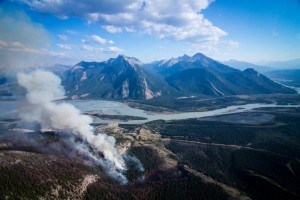
Jasper National Park has been monitoring and responding to mountain pine beetle (MPB) populations since they were first recorded in the park in 1999. Forest diseases and insects like MPB provide a natural disturbance that is important in keeping forest ecosystems healthy, resilient and diverse. Increased populations however, could pose a threat to the forest industry adjacent to the park.
Populations have increased steadily in the past few years.
During the most recent forest insect and disease survey carried out with the Canadian Forest Service, specialists found a significant increase in MPB populations in the western half of the park. Over 6,000 hectares of the park’s pine forests have now been colonized. Affected trees can be seen in and around the townsite, nearby campgrounds and day-use areas. This compares to approximately 400 affected trees found in 2012, and 1,900 affected trees in 2013.
Parks Canada’s management tool of choice is prescribed fire. Restoring fire to the landscape is an effective way to remove MPB habitat and restore healthy forests. Prescribed fire also restores and enhances important wildlife habitat, and reduces the risk of wildfire. In the past decade, many prescribed fires have been planned for and/or conducted in locations most conducive to helping stop or slow the eastward spread of MPB into neighbouring lands.
This winter, the park’s Fire Management Team will carry out prescribed burning in the Fiddle Fireguard Sub-Unit of the Fiddle Prescribed Burn Complex (a series of interconnected prescribed fire units in the east end of the park). The Fiddle
Prescribed Fire Complex covers the entire vegetated area of the Athabasca River Valley along the eastern boundary of the park, from Bedson Ridge to the north, to Roche à Perdrix to the south.
Additionally, a Parks Canada crew is presently working on the removal and disposal of beetle attack trees in our campgrounds near the town of Jasper.
Mountain pine beetle facts:
Did you know that the mountain pine beetle…
…is tiny—only about the size of a grain of rice?
…spends pretty much its entire lifecycle underneath the bark of a tree?
…is naturally occurring in British Columbia and parts of Alberta (including JNP)?
…targets any pine tree? (Lodgepole pine is JNP’s most common tree.)
…kills a tree by introducing blue-stain fungus and/or tunnelling galleries?
…develops a type of anti-freeze to help it survive the winter months?
Species at risk benefits from prescribed fire
Jasper’s fire and vegetation management team is using prescribed fire to help protect and restore important habitat for species at risk.
For example, the team has planned prescribed fires that will create fireguards to help protect the old growth forest habitat needed by Jasper’s woodland caribou. Caribou habitat is also being incorporated into the park’s wildfire response zoning, which means wildfires in or near caribou habitat are immediately and fully extinguished (as they were this summer near the north boundary).
Additionally, the park’s fire team is using prescribed fire to restore the open, sub-alpine slopes required for whitebark pine regeneration. While carrying out prescribed fires in whitebark pine habitat, fire managers protect the trees by pre-burning around them.
Parks Canada
Special to the Fitzhugh
